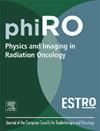合成计算机断层扫描患者特异性质量保证的临床实施
IF 3.3
Q2 ONCOLOGY
引用次数: 0
摘要
背景与目的在磁共振(MR)规划工作流中,MR图像是获取的唯一数据集。为了计算剂量沉积,生成合成CT (sCT)来代替计划计算机断层扫描(CT)。本研究旨在建立sCT患者特异性质量保证(PSQA)临床实施的可接受标准。材料与方法对60例患者进行回顾性研究。30例患者在治疗位行CT扫描,在诊断位行MR扫描。30例患者均获得治疗位CT和MR图像。对于后一组,生成用于剂量计算的sCT,并与三种PSQA方法进行比较:(a)身体的水覆盖,(B)体积密度覆盖的组织类别和(C)计划CT的重新计算。评估sCT和PSQA方法之间的相对剂量差异(ΔD[%])。PTV = ResultsΔD方法(A)的Dmean骨盆组在3%以内,脑组在4%以内,标准差小于1%。方法(B)和(C)分别保持在2%和1%以内,偏差达1%。结论本研究提出了一种鲁棒的PSQA方法,用于MR-only计划。方法(A)是一种有价值的工具,用于识别Dmean偏差(>;5%),建议作为常规的PSQA。如果方法(A)失败,方法(B)可用于骨盆病例,将检出率提高到2%。如果(A)和(B)都失败了,方法(C)可以作为退路。本文章由计算机程序翻译,如有差异,请以英文原文为准。
Clinical implementation of patient-specific quality assurance for synthetic computed tomography
Background and purpose
In a magnetic resonance (MR) only planning workflow, MR image is the sole dataset acquired. In order to calculate the dose deposition, a synthetic CT (sCT) is generated to substitute the planning computed tomography (CT). This study aimed to establish acceptance criteria for the clinical implementation of patient-specific quality assurance (PSQA) for sCT.
Materials and methods
A retrospective study was conducted on 60. 30 patients underwent a CT scan in treatment position and an MR in diagnostic position. 30 patients had both CT and MR images acquired in treatment position. For the latter group, a sCT for dose calculation was generated and compared against three PSQA methods: recalculation on (A) water override of the body, (B) tissue classes with bulk density overrides and (C) planning CT. The relative dose differences (ΔD [%]) between the sCT and the PSQA methos were evaluated.
Results
ΔD for PTV Dmean for method (A) were within 3% for pelvis and 4% for brain cohorts, with standard deviations below 1%. Methods (B) and (C) remained within 2% and 1%, respectively, with deviations up to 1%.
Conclusion
The present study proposes a robust PSQA method for MR-only planning. Method (A) is a valuable tool for identifying potential large outliers for Dmean deviations (> 5 %) and it is proposed as the routine PSQA. Method (B) can be used for pelvis cases to improve detection to the 2 % level if method (A) fails. If both (A) and (B) fail, method (C) can be used as a fall-back.
求助全文
通过发布文献求助,成功后即可免费获取论文全文。
去求助
来源期刊

Physics and Imaging in Radiation Oncology
Physics and Astronomy-Radiation
CiteScore
5.30
自引率
18.90%
发文量
93
审稿时长
6 weeks
 求助内容:
求助内容: 应助结果提醒方式:
应助结果提醒方式:


